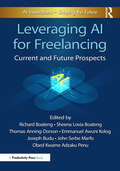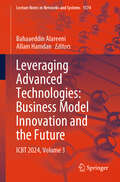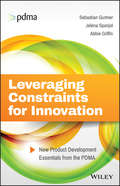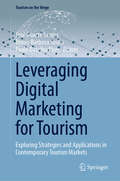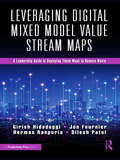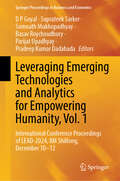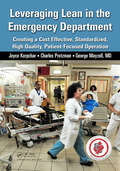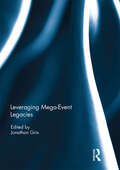- Table View
- List View
Leveraging AI for Freelancing: Current and Future Prospects
by Richard Boateng Thomas Anning-Dorson Sheena Lovia Boateng Joseph Budu Obed Kwame Adzaku Penu Emmanuel Awuni Kolog John Serbe MarfoIn recent years, the profound impact of artificial intelligence (AI) on fostering new forms of entrepreneurship has become increasingly evident. Entrepreneurs worldwide are harnessing the capabilities of AI to develop innovative solutions and create businesses that address pressing challenges.Despite the growing recognition of AI’s potential, there exists a crucial need to deepen understanding and awareness surrounding how individuals are leveraging AI to establish novel ventures. Many entrepreneurs are pioneering initiatives that deploy AI technologies to tackle complex problems. This challenge revolves around the imperative to explore, document, and comprehend the diverse ways in which AI is driving the emergence of new businesses, solving real-world problems, and reshaping the entrepreneurial landscape. It underscores the necessity for entrepreneurs, researchers, and the wider community to grasp the transformative role of AI in fostering innovation and enabling the creation of businesses dedicated to addressing societal issues. Addressing this challenge will contribute to a more comprehensive understanding of the synergy between AI and entrepreneurship, paving the way for informed and impactful ventures that leverage the full potential of AI technologies.In this respect, the purpose of this book is to offer an in-depth exploration of the intersection between AI and entrepreneurial ventures. The book aims to provide a contemporary and thorough analysis of how AI is playing a pivotal role in shaping new forms of entrepreneurship across various industries. It seeks to illuminate the ways in which entrepreneurs are leveraging AI technologies to drive innovation, address challenges, and create businesses that contribute to societal progress.Through the compilation of diverse perspectives, case studies, and practical insights, the book endeavors to serve as a valuable resource for professionals, entrepreneurs, investors, and professionals seeking to understand and navigate the dynamic landscape of AI-driven entrepreneurship.
Leveraging Advanced Technologies: ICBT 2024, Volume 3 (Lecture Notes in Networks and Systems #1574)
by Allam Hamdan Bahaaeddin AlareeniThis book examines how next-generation tools such as artificial intelligence, blockchain, and the Internet of Things are transforming not only the way companies operate, but also how they create value, define strategy, and drive growth. As emerging technologies reshape the business landscape, innovation has become a necessity rather than a choice. It offers an in-depth exploration of the evolving business model innovation landscape, combining diverse methodologies and real-world industry cases to illustrate the powerful intersection of technology and strategic transformation. Through practical insights, evidence-based analysis, and compelling case studies, this book equips decision-makers to adapt, innovate, and lead in a rapidly evolving digital environment. What You&’ll Discover: · The role of AI, blockchain, and IoT in reinventing business models · Frameworks and strategies for leveraging disruptive technologies · Policy and managerial insights to guide innovation in practice &
Leveraging Brands in Sport Business
by Mark P. Pritchard Jeffrey L. StinsonThis edited text compiles advanced material relating to strategy and marketing in the field of sports business. Featuring contributions from experts across the sports business field, the book approaches strategy from the standpoint of managing and marketing a brand. With integrated current-day examples highlighting practices and issues, as well as ‘real-world’ applied video cases, this book is ideal for marketing students and sports business practitioners looking to gain strategic insights into the industry.
Leveraging Communities of Practice for Strategic Advantage
by Hubert Saint-Onge Debra WallaceHow can you build a successful community of practice that is integrally linked to your company's strategic vision? Learn from the first-hand experience of Hubert Saint-Onge, recognized by Fortune magazine as a leader in the field of knowledge capital, and co-author Debra Wallace, the people responsible for a recent project to establish a community of practice for independent agents at Clarica Life Insurance Company— voted one of the most admired knowledge enterprises in the world by practitioners and researchers. 'Leveraging Communities of Practice for Strategic Advantage' combines theory and practice to outline a model for developing successful communities of practice and proposes a direction for establishing communities of practice as an integral part of the organizational structure. Saint-Onge and Wallace relate what worked, what didn't, and why as they tell the story from inception through implementation to assessment. Whether you're developing communities of practice or want to learn how to leverage existing communities for strategic gain, this book provides you with everything you need to launch successful communities of practice in your organization.
Leveraging Constraints for Innovation: New Product Development Essentials from the PDMA
by Abbie Griffin Sebastian Gurtner Jelena SpanjolProvides managers with actionable insight into a select set of innovation constraints and how to best deal with them This PDMA Essentials Book, the third in this series, provides a framework of individual, organizational, and market and societal constraints that guides managers in identifying specific constraints related to their innovation activities and provides them with corresponding tools and practices to overcome and leverage those constraints. Written by a team of international innovation experts, Leveraging Constraints for Innovation: New Product Development Essentials from the PDMA is presented in three parts. The first part, Individual Constraints, provides insights into how to: simultaneously solve social and commercial needs for greater creativity; apply a multi-stage approach to overcome knowledge sharing in teams; and anticipate and account for psychographic differences among customers during product launch. In the second part, Organizational Constraints, insights emerge that provide guidance on how to: identify and solve for sources of innovation constraints within the company; implement and manage virtual NPD teams; and effectively organize new service development in professional services. The last part, Market Constraints, examines how to: adapt firm capabilities to overcome constraints preventing consumers in low-end and under-resourced markets from purchasing new products; implement inclusive innovation strategies to address markets constrained by underdeveloped infrastructures; develop solutions for women and other disadvantaged market traders in emerging markets. This book: Is a single comprehensive volume that covers the full spectrum of constraint-related strategies and techniques in a coherent, integrated fashion Provides a set of frameworks, techniques, and tools that can be immediately implemented by individuals across firms Offers how-to knowledge on specific tools and methods as applied to innovating products and services when facing constraints as well as for the development of new business models Integrates problem- and solution-based knowledge to enable companies to develop sustainable growth strategies by leveraging constraints and restrictions toward innovation strategies, processes and offerings Leveraging Constraints for Innovation: New Product Development Essentials from the PDMA is an ideal book for all product development professionals, including marketers, engineers, project managers, and business managers in both startups and well-established firms, and from a broad range of industries from heavy manufacturing to the service sector.
Leveraging Corporate Responsibility: The Stakeholder Route to Maximizing Business and Social Value
by Sankar Sen C. B. Bhattacharya Daniel KorschunThe corporate social and environmental responsibility movement, known more generally as corporate responsibility (CR), shows little sign of waning. Almost all large corporations now run some form of corporate responsibility program. Despite this widespread belief that CR can simultaneously improve societal welfare and corporate performance, most companies are largely in the dark when it comes to understanding how their stakeholders think and feel about these programs. This book argues that all companies must understand how and why stakeholders react to such information about companies and their actions. It examines the two most important stakeholder groups to companies - consumers and employees - to comprehend why, when and how they react to CR. Armed with this insight, it shows how companies can maximize the value of their CR initiatives by fostering strong stakeholder relationships to develop, implement and evaluate compelling social responsibility programs that generate value for both the company and its stakeholders.
Leveraging Cultural and Political Authority: A Cultural Model of Brand Equity
by Douglas B. HoltFor iconic brands, the brand is a symbol so equity is a collective phenomenon rather than a product of a brand's hold on individual customers. The brand becomes renowned for telling certain kinds of stories that are useful in addressing certain social desires and anxieties. Therefore, identity brands succeed when their managers draw on two important assets: cultural authority and political authority.
Leveraging Culture for Innovation and Competitive Advantage
by Michael L. Tushman Charles A. O'ReillyTo manage organizational culture effectively, managers need to be clear about the type of culture and the specific norms and values that will help the organization reach its strategic goals. This chapter guides managers through the process of diagnosing organizational culture and learning how to use culture as a social control system.
Leveraging Data Science for Global Health
by Maimuna S. Majumder Leo Anthony Celi Patricia Ordóñez Juan Sebastian Osorio Kenneth E. Paik Melek SomaiThis open access book explores ways to leverage information technology and machine learning to combat disease and promote health, especially in resource-constrained settings. It focuses on digital disease surveillance through the application of machine learning to non-traditional data sources. Developing countries are uniquely prone to large-scale emerging infectious disease outbreaks due to disruption of ecosystems, civil unrest, and poor healthcare infrastructure – and without comprehensive surveillance, delays in outbreak identification, resource deployment, and case management can be catastrophic. In combination with context-informed analytics, students will learn how non-traditional digital disease data sources – including news media, social media, Google Trends, and Google Street View – can fill critical knowledge gaps and help inform on-the-ground decision-making when formal surveillance systems are insufficient.
Leveraging Data in Healthcare: Best Practices for Controlling, Analyzing, and Using Data (HIMSS Book Series)
by Rebecca Mendoza Saltiel BuschThe healthcare industry is in a state of accelerated transition. The proliferation of data and its assimilation, access, use, and security are ever-increasing challenges. Finding ways to operationalize business and clinical data management in the face of government and market mandates is enough to keep most chief officers up at night!Leveraging Dat
Leveraging Digital Marketing for Tourism: Exploring Strategies and Applications in Contemporary Tourism Markets (Tourism on the Verge)
by Bruno Barbosa Sousa José Duarte Santos Paulo Botelho PiresThis edited volume invites readers to explore the convergence of tourism and digital marketing. It navigates the intricate relationship between these two domains by elucidating the role of digital marketing across various facets of the tourism industry. Each chapter offers a blend of theoretical foundations and practical insights, delving into typologies of tourism, specific segments of tourists, and critical sectors essential to tourism's functionality. Through neutral, third-person narration, the volume presents a comprehensive examination, showcasing how digital marketing strategies are applied within diverse tourism contexts. Rich with examples illustrating theory in practice, this work serves as an essential resource for scholars, researchers, and professionals seeking a deeper understanding of this evolving landscape.
Leveraging Digital Mixed Model Value Stream Maps: A Leadership Guide to Deploying These Maps to Remove Waste
by Girish Hidaduggi Jon Fournier Herman Ranpuria Dilesh PatelThis guide serves as a roadmap for integrating digital value stream mapping (eVSM) into your Lean deployment to improve production processes. Lean, with its mapping component, value stream mapping (VSM), has endured as a process improvement methodology for more than 25 years. VSM is a metrics-based analytical mapping method with simple calculations for Lean metrics such as Takt Time, VA, NVA, Capacity, OEE, etc., however:• The calculations and charting associated with value stream maps can be tedious.• It’s hard to keep updating the calculations for “what-if” studies.• Manual calculations can be prone to error.Digital VSM was introduced as a complement to the initial paper-and-pencil map. The eVSM software has been used to create Digital VSMs for many years, but it has also encountered a couple of hurdles:• Lean application has expanded and is applied to increasingly complex value streams.• Product variants (mixed models) have proliferated so that many variants are now made with shared resources.Creating and analyzing mixed model value stream maps with only paper and pencil, however, is practically unfeasible. The eVSM program has been revamped for the mixed model production setting and is now accessible as eVSM Mix for creating and analyzing Digital Mix VSMs. The eVSM Mix software reintroduces VSM as a fundamental tool for lean practitioners working in mixed-model situations. This guide illustrates Digital Mix VSMs created with the eVSM Mix software, shows how to use them analytically for “what-if” studies, and highlights best practices for deployment.
Leveraging Disability Sport Events: Impacts, Promises, and Possibilities (Disability Sport and Physical Activity Cultures)
by Laura Misener David McGillivray Gayle McPherson David LeggThis empirically-grounded text examines the policy, planning, development and implementation of disability sport events. It draws insights from a major international comparative study of different types of large multi-national sporting events: integrated events where able-bodied athletes and athletes with a disability compete alongside one another, and non-integrated events where athletes with a disability are separated by time but occurring in the same location. Guided by a critical disability studies perspective, the book highlights the strategic opportunity of sporting events to influence social change around community participation, and attitudes and awareness about disability more broadly. It also challenges assumptions about positive event legacies and suggests a need for a multi-lateral approach to planning. An important read for students, researchers and scholars in the fields of sport policy, sport development, disability sport, sport management, disability studies and event studies.
Leveraging Emerging Technologies and Analytics for Empowering Humanity, Vol. 1: International Conference Proceedings of LEAD-2024, IIM Shillong, December 10–12 (Springer Proceedings in Business and Economics)
by Somnath Mukhopadhyay Suprateek Sarker D P Goyal Basav Roychoudhury Parijat Upadhyay Pradeep Kumar DadabadaThis book provides a platform for interdisciplinary discussions on leveraging emerging technologies and analytics to empower humanity, fostering collaboration between experts in AI and analytics, sustainability, different areas of management, and IT. As the world grapples with complex challenges, from climate change to economic inequality, this first volume of a two-volume proceedings series is a crucial resource for fostering collaboration and exploring untapped potential of emerging technologies. By harnessing the power of AI, blockchain, IoT, and big data, the chapters address critical global challenges towards improving quality of life and promoting inclusive and sustainable development, while keeping in mind ethical implications, and their impact on social justice. The volume will be of use to thought leaders, researchers, innovators, and policymakers from around the globe who are interested in knowing more on how cutting-edge technologies can be harnessed for the greater good of society.
Leveraging Emerging Technologies and Analytics for Empowering Humanity, Vol. 2: International Conference Proceedings of LEAD-2024, IIM Shillong, December 10–12 (Springer Proceedings in Business and Economics)
by Somnath Mukhopadhyay Suprateek Sarker D P Goyal Basav Roychoudhury Parijat Upadhyay Pradeep Kumar DadabadaThis book provides a platform for interdisciplinary discussions on leveraging emerging technologies and analytics to empower humanity, fostering collaboration between experts in AI and analytics, sustainability, different areas of management, and IT. As the world grapples with complex challenges, from climate change to economic inequality, this second volume of a two-volume proceedings series is a crucial resource for fostering collaboration and exploring untapped potential of emerging technologies. By harnessing the power of AI, blockchain, IoT, and big data, the chapters address critical global challenges towards improving quality of life and promoting inclusive and sustainable development, while keeping in mind ethical implications, and their impact on social justice. The volume will be of use to thought leaders, researchers, innovators, and policymakers from around the globe who are interested in knowing more on how cutting-edge technologies can be harnessed for the greater good of society.
Leveraging Emotional and Artificial Intelligence for Organisational Performance
by Catherine PrenticeThis book takes a fresh stance and views EI and AI as services that are provided by service employees and machines as organisational offerings to customers. As emotional intelligence (EI) and artificial intelligence (AI) have been cited to have broad effects on individuals, businesses and beyond, this book is focused on the organisational context, specifically how they affect employees and customers from a marketing perspective. The stance in this book is consistent with the conceptualisation of a service. This book holds that intelligence in businesses must turn into organisational assets to manifest their values. Further, this book explores this service-dominant logic era, and compared to tangible products, service plays a key role in organisational performance and customer relationship with the organisation. Intelligence exhibited either by human or machine is not a tangible product, but can be utilised as a service to assist employees in performing tasks and delivering services as well as facilitating business transaction and customer experience.This book is structured as follows. Chapters 2 and 3 demystify emotional and artificial intelligence, from different perspectives, including conceptualisations, the history and evolution of the concepts, how they function and where they can apply to. These discussions help readers understand what exactly these two intelligences are. Chapters 4 and 5 analyse how emotional intelligence is related to employees and customers, respectively, with a focus on service organisations. Chapters 6–8 are dedicated to anatomising AI and how it is operationalised as a service to influence employees and customers. Specifically, viewing AI as a service, Chapter 6 examines the impact of AI service quality and how it is related to employee service quality. Chapter 7 analyses the influence of AI service quality on customers. Based on the discussion in Chapters 6 and 7, Chapter 8 is extended to develop a scale to measure such AI service, named AI service quality.The last three chapters of this book integrate EI and AI to analyse their respective impacts on employees and customers. Chapter 9 proposes EI as a moderator of AI, whereas Chapter 10 proposes AI as a moderator of EI. Chapter 11 employs service profit chain to integrate EI and AI in the chain relationship to understand their effects on both employees and customers. This chapter broadly covers the service industry with a focus on tourism and hospitality sector. The discussion on the impact of EI and AI is complemented with empirical studies conducted in tourism or hospitality context to address their effects in these sectors.
Leveraging Financial Markets for Development: How KfW Revolutionized Development Finance (Executive Politics and Governance)
by Peter VolberdingThis book investigates how development institutions created and promoted marketized development financial instruments to increase the speed and scope of assistance by leveraging private financial markets for development objectives. To attract private investors, donor governments agreed to bear the risk in these new instruments in order to mobilize investment during times of political crisis. In particular, this book contends that Germany’s KfW played an outsized role in the development of these new financial instruments, particularly in microfinance banks and structured funds, as KfW’s unique institutional attributes and strong political support from the German government at critical junctures fostered financial innovation. Using over 70 interviews and a cache of newly released archival materials, this books documents how KfW and other development institutions created and promoted these marketized development financial instruments, and how they have become a pillar of modern development policy.
Leveraging Lean in Ancillary Hospital Services: Creating a Cost Effective, Standardized, High Quality, Patient-Focused Operation
by Charles Protzman Joyce Kerpchar George MayzellThis book is part of a series of titles that are a spin-off of the Shingo Prize-winning book Leveraging Lean in Healthcare: Transforming Your Enterprise into a High Quality Patient Care Delivery System. Each book in the series focuses on a specific aspect of healthcare that has demonstrated significant process and quality improvements after a Lean
Leveraging Lean in Healthcare: Transforming Your Enterprise into a High Quality Patient Care Delivery System
by Charles Protzman Joyce Kerpchar George MayzellWinner of a 2013 Shingo Research and Professional Publication Award, this practical guide for healthcare executives, managers and frontline workers provides the means to transform your enterprise into a High-Quality Patient Care Business Delivery System.
Leveraging Lean in Medical Laboratories: Creating a Cost Effective, Standardized, High Quality, Patient-Focused Operation
by Charles Protzman Joyce Kerpchar George MayzellThis book is part of a series of titles that are a spin-off of the Shingo Prize-winning book Leveraging Lean in Healthcare: Transforming Your Enterprise into a High Quality Patient Care Delivery System. Each book in the series focuses on a specific aspect of healthcare that has demonstrated significant process and quality improvements after a Lean
Leveraging Lean in Outpatient Clinics: Creating a Cost Effective, Standardized, High Quality, Patient-Focused Operation
by Charles Protzman Joyce Kerpchar George MayzellThis book is part of a series of titles that are a spin-off of the Shingo Prize-winning book Leveraging Lean in Healthcare: Transforming Your Enterprise into a High Quality Patient Care Delivery System. Each book in the series focuses on a specific aspect of healthcare including emergency departments, medical laboratories, outpatient clinics, ancil
Leveraging Lean in Surgical Services: Creating a Cost Effective, Standardized, High Quality, Patient-Focused Operation
by Charles Protzman Joyce Kerpchar George MayzellThis book is part of a series of titles that are a spin-off of the Shingo Prize-winning book Leveraging Lean in Healthcare: Transforming Your Enterprise into a High Quality Patient Care Delivery System. Each book in the series focuses on a specific aspect of healthcare that has demonstrated significant process and quality improvements after a Lean
Leveraging Lean in the Emergency Department: Creating a Cost Effective, Standardized, High Quality, Patient-Focused Operation
by Charles Protzman Joyce Kerpchar George MayzellThis book is part of a series of titles that are a spin-off of the Shingo Prize-winning book Leveraging Lean in Healthcare: Transforming Your Enterprise into a High Quality Patient Care Delivery System. Each book in the series focuses on a specific aspect of healthcare that has demonstrated significant process and quality improvements after a Lean
Leveraging Legacies from Sports Mega-Events: Concepts and Cases
by Jonathan GrixThis volume offers a panoramic and interdisciplinary view of the growing field of Sports Mega-Event studies. Contributions explore leveraging strategies and the legacies from previous sports megas (London, Seoul, Sydney, Vancouver) and recent and future 'emerging' states and their hosting strategies (India, China, Qatar, Russia, Brazil).
Leveraging Mega-Event Legacies
by Jonathan GrixThis is a multi-disciplinary contribution to the burgeoning literature on and around mega-events in general and sports mega-events in particular. The volume is not specifically about mega-events or their management, but rather how such events act as a lens through which a number of important and critical questions about the decisions to host, the host nation, its society and the politics of culture, sport and leisure more broadly can be dealt with. In doing so this book seeks to build on, and out from initial work on (sports) mega events by acknowledging the major shift towards ‘emerging’ states awarded such events since 2006 and incorporating the latest advances in research that have taken place in recent years. For example, debates about what constitutes a ‘mega-event’, what is meant by a ‘legacy’, what is ‘soft power’ and so on are dealt with from a team of leading academics from a variety of academic disciplines. This book was previously published as a special issue of Leisure Studies.
